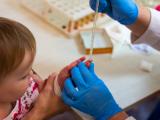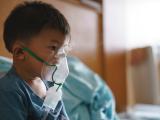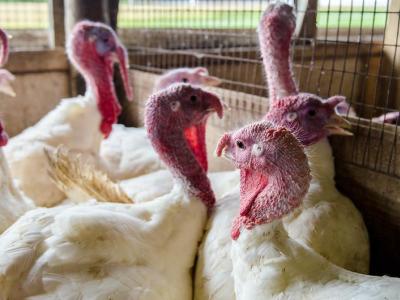Oct 2, 2008 (CIDRAP News) – In the influenza pandemic of 1918, those who got sick in the first wave of illness were up to 94% less likely to fall ill when the second and much more severe wave struck, according to a new analysis of historical data.
The authors, led by historian John M. Barry, sifted data mostly from US Army camps, along with some from the British navy and British cities, to conclude that infection in the first wave acted like a vaccine, conferring immunity that protected people when the second wave arrived. Barry wrote the 2004 book The Great Influenza, a chronicle of the pandemic.
Their analysis "strongly points to cross-protection between outbreaks of respiratory illness during spring and early summer of 1918 and the influenza pandemic wave in the fall of 1918. The cross-protection effect was estimated to range from 35% to 94% for clinical illness and from 56% to 89% for mortality," says the report, published online by the Journal of Infectious Diseases.
The authors say their findings suggest that when novel flu viruses emerge and initially cause a mild wave of illness, public health authorities should think twice before taking aggressive steps to limit exposure, since people infected with the virus might benefit later on if the virus grows more virulent and triggers another wave of cases.
Besides Barry, the authors are Cecile Viboud of the Fogarty International Center in Bethesda, Md., and Lone Simonsen of George Washington University in Washington, DC.
The pandemic of 1918-19 occurred in three waves: a mild one in the spring or summer of 1918 (depending on location), a much more severe one in the fall, and a less severe one in the winter and spring of 1919, the authors note. The first wave began in March 1918 in the US Army and spread quickly through training camps and on to some civilian communities, and then faded by June. This initial wave came later in Europe, peaking in June and July, the report notes.
US Army records show that 11.8% of all personnel at all camps were hospitalized for respiratory illness in the spring wave from March through May, compared with 27.5% during the fall wave, the report says.
Multiple tests of hypothesis
The authors used several approaches to test the hypothesis of cross-protection. One was to examine detailed data available from five US Army camps on flu cases and deaths in seasoned troops—defined as those who had been in the Army at least 1 month—and new recruits during the second wave. New recruits were considered less likely to have been exposed in the first wave, because the spring epidemic was much larger in the army than in civilian communities. In fact, in only a few civilian areas was the spring wave large enough to be recognized as an epidemic at the time, the report says.
Using these data, the investigators estimated that at two of the camps, Camp Grant and Columbus Barracks, seasoned troops were, respectively, 56% (95% confidence interval [CI], 51% to 61%) and 89% (95% CI, 66% to 97%) less likely to die in the second wave, compared with new recruits. For the other camps, the seasoned troops, as compared with new recruits, had protection against clinical illness estimated at 94% (95% CI, 90% to 97%) for Fort McDowell, 49% for Camp Pike (95% CI, 48% to 51%), and 86% (95% CI, 84% to 87%) for Camp Lee.
The investigators acknowledge that some of the seasoned troops could have escaped the spring wave of illness and that some of the new recruits might have been exposed to the flu as civilians. But the resulting bias in their estimates would go against showing a protective effect, resulting in an underestimation rather than an overestimation of the true benefits, they write.
The authors also found useful data on two regiments of seasoned troops who were trained at Camp Dodge in the fall of 1918; one regiment had been exposed to the spring wave while stationed in Hawaii, and the other had escaped it while in Alaska. Of those who had been exposed in the spring, 6.6% (198 of an estimated 3,000 troops) contracted flu in the fall. In the regiment that had been in Alaska, 48.5% (1,455 of an estimated 3,000) became sick in the fall. In this case, the protective effect of prior exposure was estimated at 86% (95% confidence interval, 84% to 88%).
Data from the British Grand Fleet offered another opportunity for assessing cross-protection. A 1919 report in a medical journal supplied the numbers of sailors, out of the fleet total of 90,000, who were sick during each of the two waves and during both waves. From these numbers, the authors estimated that those who were sick in the spring had 72% protection (95% CI, 68% to 76%) against the fall wave.
A British government report on flu cases in 12 civilian communities with a total population of 24,706 provided still another pathway for testing the hypothesis. In this population, 11.6%, or 2,863 people, were hit by the first wave. The authors estimated that these people gained 35% protection (95% CI, 27% to 43%) against the second wave, compared with those who escaped the earlier wave.
However, using data from the same report, the investigators concluded that illness during either the first or the second wave did not seem to confer protection against the third wave in the winter.
But overall, the authors conclude, illness in the first wave yielded about as much protection against the second wave as modern flu vaccines, which are about 70% to 90% effective in healthy adults. The finding of cross-protection matches the impressions of contemporary US Army epidemiologists, they note.
Viral evolution and cross-protection
Barry and colleagues write that the simplest explanation of their findings is that the spring and fall waves of the pandemic were caused by "sequential variants" of the influenza A/H1N1 virus. The spring virus might not have been fully adapted to humans, they say, since it apparently didn't spread effectively in civilian communities. By fall, it had evolved into a fully human-adapted and more virulent form.
But there is at least one other possible explanation: that nearly identical viruses circulated during both waves, but respiratory bacterial pathogens exacerbated the disease in the fall.
The authors suggest that their findings may help explain why pandemic mortality rates in the fall of 1918 varied almost fourfold among US cities. Though recent studies suggest that these differences can be largely explained by differences in nonpharmaceutical interventions, "we propose that geographical differences in population immunity acquired during the first wave could have contributed to the observed variation during the second wave," they write.
The investigators see at least two policy implications in their findings. One is that timely surveillance is crucial for learning the transmissibility, virulence, and age-group impact of influenza in the early stages of a pandemic.
"Second, if indeed a mild first wave is documented, the benefits of cross-protection during future waves should be considered before implementing public health interventions designed to limit exposure," they write.
Other experts impressed
Several other infectious disease experts said they were impressed with the study and found it convincing, though one military medical historian saw problems with some details of the data presented.
"I think you have to say they make a strong circumstantial case," said Richard J. Hatchett, MD, of the National Institute of Allergy and Infectious Diseases (NIAID), who has studied the effects of nonpharmaceutical interventions in the 1918 pandemic.
"It's really amazing that we can go back after almost 100 years and get any useful data on an epidemic that occurred in 1918," said Hatchett, who is an associate director of emergency preparedness in the NIAID's Division of Allergy, Immunology and Transplantation.
He said the evidence of a sizable spring epidemic in cramped Army camps but only a minor one in civilian communities suggests that initially the virus was not well-adapted for human-to-human transmission and that the camps, with their continual influx of new recruits, may have served to incubate and sustain the virus until it became more transmissible and much more lethal.
"If this were the case, the fall pandemic would've been a direct consequence of the war and social arrangements that allowed this inefficient virus to spread through the population. There's probably a useful lesson in that experience, if that speculative observation were proved," he said.
"I'm not sure there is any direct application of the results of this paper to current pandemic planning," Hatchett said. He added, however, "I think their [the authors'] recommendation of not implementing aggressive nonpharmaceutical interventions in a mild pandemic is in line with what the government is currently recommending." He referred to Centers for Disease Control and Prevention (CDC) guidelines, which link interventions to a pandemic severity index.
Dr. Christophe Fraser, an infectious disease epidemiologist at Imperial College London, said Barry and colleagues' results are in line with his own findings in a study that has not yet been published.
"We have analyzed some previously unpublished data from the USA in 1918, and our conclusions are very concordant with Dr. Barry and collaborators' work, and even go a bit further," Fraser told CIDRAP News by e-mail.
He also commented, "This issue, of whether the population was protected by exposure to a limited spring epidemic of flu, is rather important for the current debate as the fall wave of 1918 is being used as one of the baseline scenarios for pandemic preparedness. If a significant proportion of the population were actually immune, then that means it's not a good baseline to plan around."
Fraser said Barry and colleagues' findings—combined with certain other evidence, such as a recent report that Scandinavian countries had a major spring epidemic—suggest that that fall wave of 1918 would have been worse without the protective effective of the earlier epidemic.
"This is not as outlandish as it may seem," he wrote. "Indeed one of the big discoveries from the historical record, now widely replicated, is that the 1918 fall wave virus was not very infectious. It was virulent, even lethal in many cases, but not easy to transmit compared to many other common viruses."
Some discrepancies seen
Carol R. Byerly, PhD, a historian at the University of Colorado and author of the 2005 book Fever of War: The Influenza Epidemic in the US Army during World War I, said that some Army physicians at the time had a sense that soldiers who were sickened in the spring of 1918 may have had some immunity when the second wave of flu arrived in the fall. But, while making clear she is not an epidemiologist, she said she saw some flaws in the data.
For a few examples, she said:
- The report says that the Army conducted disease surveillance at 37 of 39 training camps, but the Medical Department provided detailed information on at least 40 camps, all of which did surveillance.
- The authors say that five Army camps provided detailed data for illnesses and deaths as a function of length of time in service, but she knows of at least eight monographs on the experiences at individual camps.
- Army medical officers' definition of "seasoned" recruits varied in different studies, so it is inaccurate to state that the criterion was clearly defined as just 1 month of service. Most studies used 3 or 4 months.
- Whereas the report says Army documents show that 475,000 men had respiratory illness in 1918, the actual figure War Department records show for all hospitalizations for respiratory illness in 1918 is 756,676.
"I am therefore concerned about the construction of a statistical analysis on top of such a poorly defined database," Byerly said.
Reconsidering assumptions
Another disease expert, Michael T. Osterholm, PhD, MPH, said he found the study "quite convincing," adding, "I think it adds another piece to our understanding of what happened" in 1918.
The results suggest a possible need to rethink some assumptions about pandemics, which by definition involve viruses to which the population has no immunity, said Osterholm, who is director of the University of Minnesota Center for Infectious Disease Research and Policy, publisher of CIDRAP News.
"If we have wave 1 and it's relatively mild, and a number of people are exposed to that virus, that may actually be a very positive thing relative to a second wave in which the disease is much more severe," he said. "That could mean a lot of infection in a first wave is actually a good thing, with much of the world not having a vaccine."
But he added, "This is all theoretical. . . . As to whether there are any policy decisions we should make on the basis of this, I think at this point it's just unclear."
"I think the point it demonstrates very clearly is that pandemic waves may act very differently, in large part due to the virulence of the virus and the subsequent immunity that may develop," Osterholm said.
Barry JM, Viboud C, Simonsen L. Cross-protection between successive waves of the 1918-1919 influenza pandemic: epidemiological evidence from US Army camps and from Britain. J Infect Dis 2008 Nov 15;198 (early online publication) [Abstract]


















